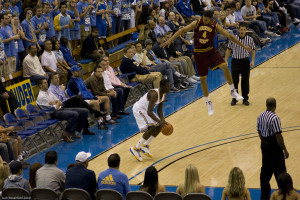Teaching the Shot Fake
The Shot Fake is one of the great supplementary skills a basketball player can develop to help gain an advantage. The Shot Fake has the ability to confuse and physically shift a defender, which can be exploited in the form of a timing, foot speed or uncontested shot advantage by an offensive player. No defensive player can make the right read against a well-executed Shot Fake all the time, so the more an offensive player becomes competent and confident in using this technical skill the more likely they will be able to reap the rewards created.
The Shot Fake while not a complex movement does have some fundamental aspects that need to be performed with consistency to make it effective. If not, then the Shot Fake can become useless as a tool.

The first teaching point to consider is having players remain in a balanced stance while performing the Shot Fake. All too often players tend to perform the technique of the Shot Fake only to force themselves out of good body position and end up losing any advantage gained through defensive reaction. As players are performing a Shot Fake direct the player to keep their feet still and remain in a low squatting stance. This will allow players to generate the maximum amount of explosive speed possible to get around the defensive player in front of them. Alternatively, this power might be used to elevate over the defender for the shot following a Shot Fake that results in a defender jumping to contest a shot.
The second key teaching point when perfecting the Shot Fake is for player to maintain a controlled position of their back and shoulders. It is not uncommon for coaches to view that player when performing a Shot Fake throw their back and shoulders away from the basket in an attempt to oversell the performance. This is not needed however and only serves to make the execution of the Shot Fake seem staged and false, which in time results in less and less defensive players falling for the fake in general.
The next key instruction for players performing the Shot Fake is to reduce the amount of movement of their head to that which is consistent with them shooting the ball. Many players throw their head back and again oversell the fake. This is not needed and while the movement of the head is important as a reading point for the defence, it should not disadvantage the offensive player by having them lose sight of the defender, basket, or the court in general. A slight elevation of the chin and the eyes fixing from the half court to the basket for a few moments should be enough to sell the Shot Fake sufficiently to the defence.
Probably the most understated teaching point about the Shot Fake is that the primary movement involves the arms. The position of the hands and arms needs to replicate a shooting stance positioning and the ball must be raised up to above the level of the eyes so the offensive player can look at the defender to see how they are reacting. The Shot Fake is performed with a large movement of the arms that replicates the ball positioning of the players normal shooting action. For all this large arm movement this is counterbalanced by little movement in the rest of the body apart from the reproduction of a good, balanced and technically proficient shooting stance.
The arms should remain flexed at the elbow and never extend. This once again is so power for a quick dribble can be easily generated and performed at haste.
Any fake needs to be performed at around fifty to seventy-five precent of normal game pace. The timing when using a Shot Fake should be slow fake and fast reaction. If the fake is performed too fast, then the defence will not have time to react and therefore there will be no advantage to then be exploited.
When coaching players need to be provided with a range of tools that they can practice and refine to gain a competitive advantage over the defence. By introducing these skills early to players in their basketball development allows them to become more familiar with these techniques and in so feel more comfortable with performing them at training sessions and in games.








Leave a Reply